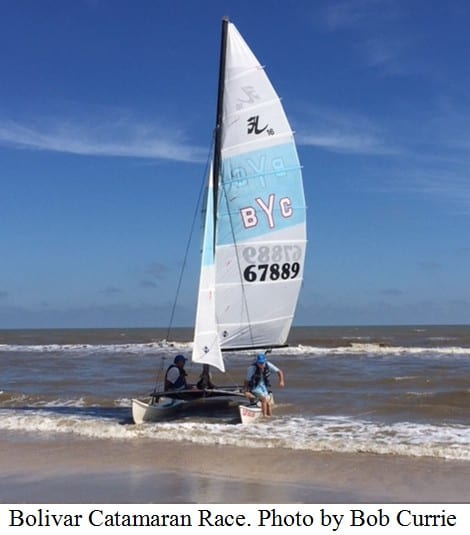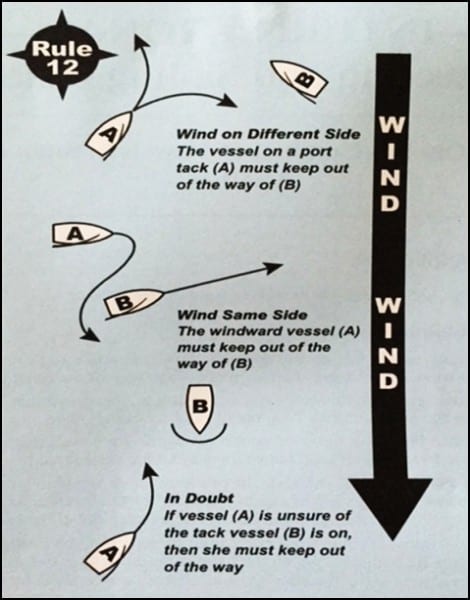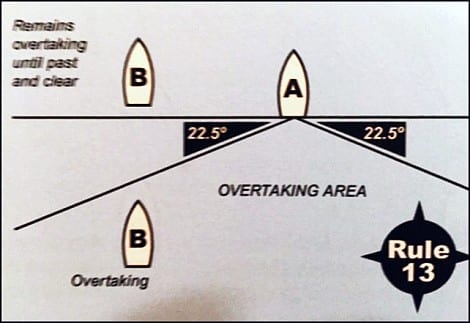 By Bob Currie, Vessel Examiner
By Bob Currie, Vessel Examiner
United States Coast Guard Auxiliary Flotilla 081-06-08
The last column was about the conduct of vessels in sight of one another, otherwise known as the pecking order of rights of way. This column will be about sailing vessels within sight of each other. But first, I am reposting the pecking order between boats. It seems we have had some collisions in our area, so maybe this will be useful information to area boaters.
Flotilla 081-06-08 is based at Coast Guard Station Galveston. The Coast Guard Auxiliary is the uniformed civilian component of the US Coast Guard and supports the Coast Guard in nearly all mission areas. The Auxiliary was created by Congress in 1939. For more information, please visit www.cgaux.org.
Rule 18 – Responsibilities Between Vessels (The Pecking Order)
Except where Rules 9 (Narrow Channels), 10 (Traffic Separation Schemes), and 13 (Overtaking) require:
(a) A power-driven vessel shall keep out of the way of:
(i) a vessel not under command (NUC);
(ii) a vessel restricted by her ability to maneuver (RAM);
(iii) a vessel engaged in fishing;
(iv) a sailing vessel.
(b) A sailing vessel underway shall keep out of the way of:
(i) a vessel not under command (NUC);
(ii) a vessel restricted in her ability to maneuver (RAM);
(iii) a vessel engaged in fishing.
(c) A vessel engaged in fishing while underway shall, as far as possible, keep out of the way of:
(i) a vessel not under command (NUC);
(ii) a vessel restricted in her ability to maneuver (RAM).

Rule 12 – Sailing Vessels
(a) When two sailing vessels are approaching one another, so as to involve risk of collision, one of them shall keep out of the way of the other as follows:
(i) when each has the wind on a different side, the vessel that has the
wind on the port side shall keep out of the way of the other;
(ii) when both have the wind on the same side, the vessel that is to windward
shall keep out of the way of the vessel that is to leeward;
(iii) if a vessel with the wind on the port side sees a vessel to windward and
cannot determine with certainty whether the other vessel has the wind on the
port or on the starboard side, she shall keep out of the way of the other.
(b) For the purposes of this Rule, the windward side shall be deemed to be the side opposite to that on which the mainsail is carried or, in the case of a square-rigged vessel, the side opposite to that on which the largest fore-and-aft sail is carried.
For the purpose of the Rule above, “windward” is the direction upwind from the point of reference and “leeward” is the direction away from the wind.

Exceptions to the Rule
There are three exceptions that come to mind with this rule. First, if a sailing vessel operating outside a narrow channel encounters a sailing vessel that is restricted to operating within a narrow channel, she cannot impede the restricted vessel’s progress (Rule 9, Narrow Channel Rule).
Second, if one sailing vessel is overtaking another, then according to Rule 13, the overtaking vessel shall keep out of the way of the vessel being overtaken, no matter what tack she is on or which vessel is to windward (Rule 13, Overtaking). Under Rule 13 á vessel shall be deemed to be overtaking when coming up with another vessel from a direction more than 22.5 degrees abaft her beam; that is, in such a position with reference to the vessel she is overtaking, that at night she would be able to see only the sternlight of that vessel but neither of her sidelights. (Abaft means “behind or aft of a vessel’s beam.” The beam is defined as the width of a vessel at its widest point.

A vessel remains “overtaking” until it is past and clear the overtaken vessel.
Finally, if a sailing vessel is fishing, restricted in its ability to maneuver or not under command as defined in Rule 3 (General Definitions), another sailing vessel would be required to keep clear out of the way, no matter what tack the vessel was on (Rule 18, above).
This is a lot to remember, but if both vessels practice the Rules of the Road then close maneuvering is fairly safe. It is when the other vessel doesn’t know what to do or knows but fails to follow the rules that problems occur. Regardless of what the other vessel does, it is up to both vessels to operate in such a manner as to avoid a collision. When you see that the other vessel is not following the rules, then take evasive action.
For more information on boating safety, please visit the Official Website of the U.S. Coast Guard’s Boating Safety Division at www.uscgboating.org. Questions about the US Coast Guard Auxiliary or our free Vessel Safety Check program may be directed to me at [email protected]. I am available to perform free Vessel Safety Checks, and I will come to your location to perform them. SAFE BOATING!
[9-24-2018]

 Posted in
Posted in 
























Thanks for posting these important Rules of the Road Bob. These are very helpful especially when other boats are present.